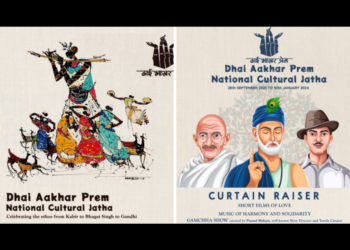Yusuf Arakkal, who loved to socialise, had withdrawn from the world he loved. It was probably a time for introspection about reality and coming to terms with himself. After having been one of the senior students of Chitrakala Parisath, he moved to Garhi studio in the 1980’s in Delhi to explore his vision, and moved from a regional to a national arena of visual art. He soon was amongst the most creative contemporaries of the 80’s and 90’s. To the city of Bangalore, he was an artist who had tasted success. He was an engaging storyteller and was keen to narrate his autobiography to anyone who had a patient ear. Arakkal was his own PR machine. He connected with galleries, critics, and the media with effortless ease. There was a constant effort to iconise the self through publications during his exhibitions. His ability to connect to the rich and famous but still be grounded to the reality around him was exemplary and rare.
Yusuf Arakkal (1945-2016) lived a full life and was scripting his swan song in his last show. At 70, Yusuf felt that he had had a long innings. It had been a tiring life. In his latest show, he paid homage to the modern artists of his time. He created a large portfolio of artists, friends, associates, and historical artists. In this pantheon of artists, there is an underlying intent to enshrine his legacy, and of others, within the art history of the nation.
The art world had changed dramatically and became very challenging – “cutting edge” and conceptual art were the new buzzwords. Arakkal was a modernist and was constantly innovating to push the boundaries of his limitations by referring to other artists. Unfortunately it did not take his work to another level. It only became a pastiche of his own work. There was a sense of being ignored by the establishment and overtaken by the yuppie generation of younger artists who had hit the international headlines.
There is an inherent humanism in the search of Yusuf's life and work, and the artist's reality has been a window to witness the world. It is also a mirror that reflects our reality. The artist's work depicts and narrates stories of people seen and read about. In many of his works the artist distills the human predicament, like his early poignant terracotta sculptures that depict the African famine.
Many envied Yusuf’s “rags to riches” story. He had a vision to become a star and he did, through his talent as an artist as well as an open and gregarious personality. He was a people’s man and was open to talk to young artists who looked up to him. He went on to support many of them and launch them into the art world.
Yusuf focused on figuration and this was his forte. He was also ambitious and challenged himself to explore material possibilities.
He will be remembered for his undeniable sprit of working his way against all odds to become one of the most prominent artists of Southern India. His passion for his work had no barriers; he explored and experimented relentlessly with printmaking, painting, sculpture and making murals.
Yusuf constantly related to people and the human predicament. He wanted to depict a slice of reality like a documentary photographer, or a short story writer who captures a small fragment of life, like a haiku. Like his favorite Malayali writer Basheer, he was an astute observer of poverty, pathos and philosophy. He wanted to see poetry in the mundane, and capture that glimmer of hope that nurtures the sprit that is fragile. Many of us who knew Arakkal as an artist and a generous human will miss him — a rare, warm, and an affectionate person.




